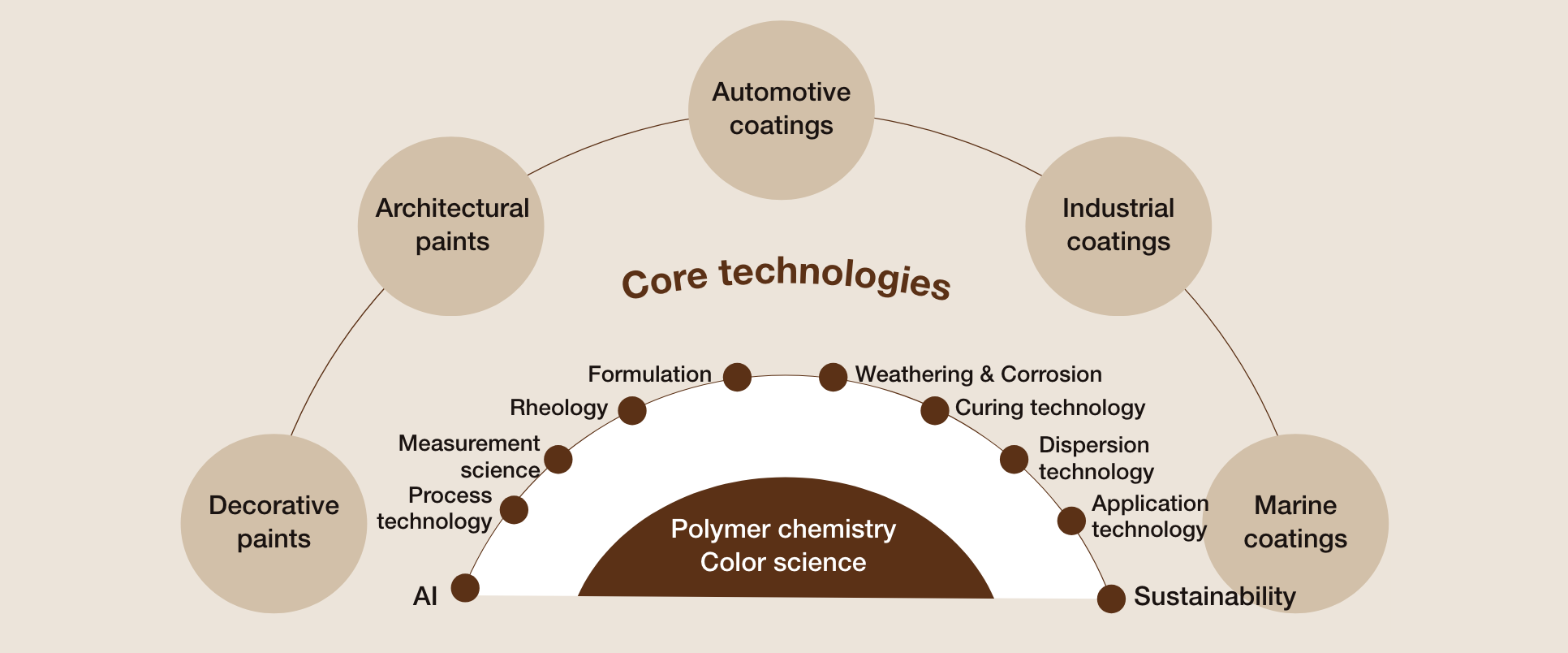Development policy and framework
R&D Strategy
The world is seeing the emergence of numerous problemsthat are difficult to solve by using methods of prioryears. To help solve these problems, we will use manypartnerships to further upgrade our ability to createinnovative ideas.
Our approach to achieving MSV
Our technology mission is to drive and sustain growth and market share in Japan and globally as a leading technology organization for coatings and adjacent markets. We have formulated our innovation strategy with three pillars: 1) build an adaptive organization; 2) develop core enabling technology competency; and 3) expand into adjacencies and emerging markets. These are initiatives for MSV from a technology perspective. We believe that our technology organization’s culture of being customer-centric, socially responsible and collaborative is the key driver to success.
LSI (Leveraging, Sharing, and Integration) is a collaborative activity within our global R&D partner companies. It involves 14 projects from multiple regions or segments, with a projected business impact of USD530 million over the next three years. In addition to these projects, the technology teams in decorative paints have established a global technical community to exchange best practices and leverage research capabilities in joint technology development projects as part of LSI. These initiatives aim to break down silos, encourage collaboration, and optimize the organization's collective expertise and assets for MSV.
R&D framework and core technologies
Nippon Paint Group has approximately 4,300 technical staff globally, including about 990 in Japan. They are the driving force of our powerful innovation and core enabler of competitiveness for achieving sustainable business growth. We have technology teams at 53 R&D and technical centers to serve our customers and consumers worldwide, including our major R&D centers in Tokyo and Osaka in Japan, Shanghai in China, Singapore, Melbourne in Australia, Los Angeles and Cleveland in the US, and France in Europe. In 2023, R&D expenditures was over 29.99 billion yen and there were 319 patent applications. As of the end of 2023, the Group had more than 1,610 patents.
Nippon Paint Group has classified its core technologies involving paint and coatings and manages its intellectual property portfolio in 12 categories: polymer chemistry, color science, formulation, curing technology, dispersion technology, application technology, process technology, rheology, weathering and corrosion, measurement science, AI and sustainability.
technology field are working in core R&D teams in the R&D centers and collaborating with scientists from the global network of technical centers to support product development across the group. Nippon Paint Group possesses a broad open innovation network with universities and academic research institutions worldwide.
In 2020, Nippon Paint Group entered into a strategic research partnership with The University of Tokyo, resulting in the establishment of the University of Tokyo & Nippon Paint joint laboratory. The partnership aims to create innovative coating technologies in three fields, namely, infectious disease risk reduction, social cost and environment burden control, and contributions to smart society. In Singapore, NIPSEA Group has been collaborating with the research institutes of A*STAR (Agency for Science, Technology and Research) for decades. Recently, NIPSEA Group has strategically joined hands with A*STAR to develop disruptive technologies in the fields of smart surface enabling autonomous driving and the use of artificial intelligence in coating research.
Moreover, in 2023, Nippon Paint Group joined the Massachusetts Institute of Technology Industrial Liaison Program (MIT-ILP), which is dedicated to creating and strengthening mutually beneficial relationships between MIT and companies worldwide.

Innovation initiatives and programs
We developed the New Product Sales Index (NPSI) as one of the indicators for measuring the sales volume of products produced using innovative technologies, as part of our efforts to foster innovation. Nippon Paint Group has defined NPSI as the percentage of sales revenues generated from new products commercialized in the past three years to the total sales revenues. NIPSEA Group started using the NPSI in 2018 and Japan Group in 2022. Japan Group and NIPSEA Group achieved a combined NPSI of 25% and launched approximately 10,000 new products in 2023.

